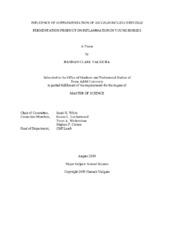| dc.description.abstract | Mitigation of exercise-induced stress is of key interest in determining means by which to optimize performance horse health. To this end, dietary interventions that may attenuate damaging responses to stress in performance horses have received much attention but have yet to be clearly elucidated. The objective of this study was to test the hypothesis that dietary supplementation with a Saccharomyces cerevisiae fermentation product (Original XPC, Diamond V Mills, Inc., Cedar Rapids, IA) would decrease markers of exercise-induced stress in young horses. Quarter Horse yearlings (mean ± SD; 9 ± 1 mo) were fed a basal diet consisting of 1.25% BW/d (DM basis) custom-formulated commercial grain split into 2 equal feedings per day plus coastal bermudagrass hay ad libitum. Yearlings were balanced by gender, age, BW, and farm of origin and randomly assigned to one of two treatment groups: 1) no supplementation (CON; n=9), or 2) 21 g/d Saccharomyces cerevisiae fermentation product (10.5 g/feeding; SCFP; n=10). After 8 wk of treatment, horses underwent a 2-hr standardized submaximal exercise test (SET) on a free stall mechanical exerciser.
Serum was collected before supplementation (wk 0), and at wk 8 pre-SET, and 0, 1, and 6 hr post-SET, and evaluated for serum amyloid A (SAA), cortisol, and cytokine concentrations by commercial ELISA. Data were analyzed using the mixed procedure in SAS v9.4 with repeated measures (time). Diet, time, and the diet × time interaction were included as fixed effects and horse(diet) was a random effect. In response to the SET at wk 8, SAA increased at 6 hr post-SET in CON (P < 0.0001) but was unchanged through 6 hr post-SET in SCFP. Serum cortisol increased in both groups immediately after the SET (0 hr post-SET; P ≤ 0.0005) but returned to pre-SET levels in SCFP by 1 hr post-SET. At 6 hr postSET, cortisol in CON had returned to pre-SET concentrations, while SCFP declined to be lower than pre-SET (P = 0.0001) and lower than CON (P = 0.01) at that time point. Eight weeks of dietary supplementation with 21 g/d of SCFP may mitigate stress following prolonged exercise in young horses. | en |


